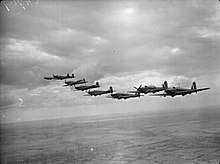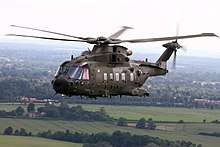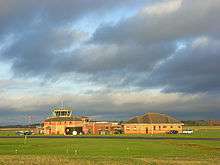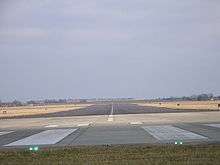RAF Benson
| RAF Benson | |||||||
|---|---|---|---|---|---|---|---|
| Near Benson, Oxfordshire in England | |||||||
_(2).jpg) Benson village (left) and RAF Benson (centre and right) from the air | |||||||
 | |||||||
 RAF Benson Shown within Oxfordshire | |||||||
| Coordinates | 51°36′59″N 001°05′45″W / 51.61639°N 1.09583°WCoordinates: 51°36′59″N 001°05′45″W / 51.61639°N 1.09583°W | ||||||
| Type | Royal Air Force station | ||||||
| Site information | |||||||
| Owner | Ministry of Defence | ||||||
| Operator | Royal Air Force | ||||||
| Controlled by | Joint Helicopter Command | ||||||
| Website |
www | ||||||
| Site history | |||||||
| Built | 1939 | ||||||
| In use | 1939-Present | ||||||
| Garrison information | |||||||
| Current commander | Group Captain Hamish Cormack MA RAF | ||||||
| Airfield information | |||||||
| Identifiers | IATA: BEX, ICAO: EGUB, WMO: 3658 | ||||||
| Elevation | 69 metres (226 ft) AMSL | ||||||
| |||||||
Royal Air Force Benson or RAF Benson (IATA: BEX, ICAO: EGUB) is a Royal Air Force station near Benson in South Oxfordshire, England. It is home to the Royal Air Force's fleet of Puma HC2 support helicopters, comprising No. 33 Squadron and No. 230 Squadron. Other flying units comprise No. 28 Squadron which is the combined Puma and Boeing Chinook HC4 operational conversion unit, Oxford University Air Squadron and No. 6 Air Experience Flight.
RAF Benson opened in 1939 and during the war operated as a training station and later in the photographic reconnaissance role. Post-war, Benson operated under RAF Transport Command throughout the 1950s and 1960s. During the 1970s various signals units arrived and in the early 1990s the station began its current support helicopter role.
The RAF Agusta Westland AW101 Merlin fleet was based at Benson between 2001 and 2016, after which it transferred to the Royal Navy to become part of the Commando Helicopter Force at RNAS Yeovilton. Other notable units which have been located at Benson include the Queen's Flight (originally the King's Flight when established in 1946).
The National Police Air Service and the Thames Valley and Chiltern Air Ambulance are present on the station, both operating the Eurocopter EC135.
History
Early years and World War II

Construction of RAF Benson began in 1937 as part of the expansion of the RAF and in response to the threat of war from Nazi Germany.[2] Construction was undertaken by contractors John Laing & Son.[3] Benson was officially opened as an RAF station on Saturday 1 April 1939 under the command of Group Captain R T Leather AFC. The station's first aircraft were two squadrons of Fairey Battle light bombers, which began to arrive a few days later. No. 103 Squadron arrived from RAF Boscombe Down and started flying in on 3 April 1939, to be joined in the next few months by No. 150 Squadron which arrived from RAF Abingdon.[2]
The Battles were replaced in December 1940 with Vickers Wellington medium bombers. At the same time the Supermarine Spitfires of No. 1 Photographic Reconnaissance Unit (PRU) and RAF Coastal Command arrived. Benson gained considerable fame as the home of photographic reconnaissance for the remainder of the Second World War.[4] In June 1943, No. 1 PRU was formed into No. 106 Wing, with five squadrons (No’s 540 to 544 inclusive) and No. 12 Operational Training Unit.[5]
The Wing was elevated to the status of No. 106 (Photo Reconnaissance) Group in April 1944, with two de Havilland Mosquito and two Supermarine Spitfire squadrons (No. 543 Squadron having been disbanded when the aircraft strength per Squadron was increased). The group was assigned to Coastal Command's photo reconnaissance assets with the whole of Northern Europe as its operational area.[6] Spitfire and Mosquito aircraft flew missions over occupied Europe, including the provision of battle damage assessment images after Operation Chastise, the attack on German dams by No. 617 Squadron in May 1943. This period of the station's history is reflected in the use of a full-scale replica of a wartime Spitfire PR.Mk XI on the main gate - this having replaced a genuine Spitfire PR.MK XIX that has been restored to flying status. Vera Lynn, 'the forces Sweetheart', visited RAF Benson to entertain the troops, reportedly singing "The White Cliffs of Dover" at the station[7].
Post-war
Benson retained a photographic reconnaissance role for some years after the war, with Avro Lancaster, Spitfire, Mosquito, Gloster Meteor PR.Mk 10 and English Electric Canberra PR.Mk 3 aircraft operating in the role.
Ferry Squadron was here between 1956 and 1958.
On 1 June 1962 No. 105 Squadron reformed at the station, flying Armstrong Whitworth AW.660 Argosys as part of the RAF Transport Command fleet. In January 1968, No. 114 Squadron[8] and No. 267 Squadron were flying Argosys as a wing on the station.
The King's Flight moved to Benson from RAF Hendon and would stay (renamed as the Queen's Flight after the death of King George VI) until after the war, moving to RAF Northolt in 1995.
The future of RAF Benson was in doubt for some time, while Project Belvedere was looking into closing at least one of Joint Helicopter Command's airfields. These included Benson, Odiham, Aldergrove, Yeovilton, Middle Wallop, Wattisham and Dishforth; with the Support Helicopters based at RAF Benson being considered for a move to RAF Lyneham. Belvedere has been abandoned on cost grounds, and Benson's future is now believed to be safe.
21st century

The Strategic Defence and Security Review 2010 recommended that in order to replace Navy's ageing Westland Sea King HC4's, the RAF's AgustaWestland AW101 Merlin fleet should be transferred to the Royal Navy's Commando Helicopter Force. To gain experience of operating and maintaining the Merlin, Royal Navy aircrew and engineers were integrated into the Merlin Force at Benson during 2012.[9]
The fleet was officially handed over to the navy during a ceremony at Benson on 30 September 2014. It was attended by Their Royal Highnesses The Duke of York, the Commodore-in-Chief of the Fleet Air Arm, and Prince Michael of Kent, Honorary Air Marshal of RAF Benson. Air Chief Marshal Sir Andrew Pulford and 1st Sea Lord and Chief of the Naval Staff, Admiral Sir George Zambellas were also present.[9] The ceremony marked the disbandment of No. 78 Squadron and its replacement by 846 Naval Air Squadron (NAS).
During July 2015 845 Naval Air Squadron reformed and replaced No. 28 Squadron which disbanded. The last phases of the transition began when 846 NAS moved to RNAS Yeovilton on 26 March 2015.[10] The final Merlin (serial number ZJ131) along with 845 NAS departed on 16 June 2016, bringing nearly 15 years of Merlin operations at Benson to a close.[11]
In 2015, it was announced that The Chinook Operational Conversion Flight will transfer from RAF Odiham, in Hampshire, to Benson in "late autumn".[12]
Operations

RAF Benson's mission statement is to 'Deliver support helicopter operational capability.'[13] To fulfil this mission, the station is home to two squadrons of Puma HC2 support helicopters under the control of the tri-service Joint Helicopter Command. The Puma is a medium-lift helicopter used for tactical troop and load movements across the battlefield. The aircraft can carry up to 16 passengers or 12 fully equipped troops, or up to two tonnes of freight carried either internally or as an under-slung load.[14] No. 28 Squadron is the combined Puma and Boeing Chinook HC4 operational conversion unit which trains crews for both aircraft types. Flying operations are supported by units such as the Rotary Wing Operational Evaluation and Training Unit and Medium Support Helicopter Aircrew Training Facility which operates a variety of simulators.[15]
RAF Benson is also home to the Grob Tutor light aircraft of the Oxford University Air Squadron. The station has its own flying club, which consists of service and civilian personnel. The National Police Air Service have a unit based at Benson alongside the Thames Valley Air Ambulance which moved from White Waltham Airfield in January 2007. Both services operate the Eurocopter EC135.[15]
The airfield is a well-known frost hollow, often recording the coldest temperatures in the UK. In early 2009 the Met Office at RAF Benson recorded a temperature of −11.8, and on 7 January 2010, −17.1 °C.
Based units

Flying and notable non-flying units based at RAF Benson.[15]
Royal Air Force
No. 2 Group (Air Combat Support) RAF / Joint Helicopter Command
- No. 28 Squadron – Chinook HC4 and Puma HC2
- No. 33 Squadron – Puma HC2
- No. 230 Squadron – Puma HC2
- Joint Helicopter Support Squadron
- Medium Support Helicopter Aircrew Training Facility
- Puma Depth Support Hub
- Rotary Wing Operational Evaluation and Training Unit
- Support Helicopter Standards Evaluation Wing
Civilian
- National Police Air Service – Airbus H135
- RAF Benson Flying Club – Cessna 152, Slingsby T67 Firefly and Piper PA-28
- Thames Valley Air Ambulance – Airbus H135
Accidents and incidents
- In the early hours of 2 August 1940 a Fairey Battle took off from Benson for a cross-country training exercise but crashed into a nearby hill. The crew included Richard Ormonde Shuttleworth, founder of the Shuttleworth Collection in Bedfordshire, who was killed.[16]
- On the evening of 29 November 1940 Fairey Battle I L5071 took off from Benson for a training flight. It reached an altitude of about 1,000 feet (300 m) but then dived and crashed about 1 mile (1.6 km) northwest of the airfield.[17]
- The Battle was crewed by three members of the Polish Air Force, all of whom were killed. They are buried in St Helen's parish churchyard, Benson.[17]
- Early in the 1950s an RAF Mosquito missed Benson airfield in fog and crashed into a hill in the Chiltern hills above Lower Farm, Swyncombe.
See also
References
- ↑ Pine, L.G. (1983). A dictionary of mottoes (1 ed.). London: Routledge & Kegan Paul. p. 218. ISBN 0-7100-9339-X.
- 1 2 "History - Pre-War". RAF Benson. Retrieved 11 October 2017.
- ↑ Ritchie 1997, p. 91.
- ↑ Leaf 1997
- ↑ "Groups 1-9". rafweb.org. Retrieved 12 September 2015.
- ↑ Coastal Command Group Dispositions - July 1945
- ↑ "BBC - WW2 People's War - Corporal Lena of RAF Benson 423254". www.bbc.co.uk. Retrieved 2018-08-02.
- ↑ RAF, No 114 Squadron, accessed November 2008
- 1 2 "RAF Hand Over Merlins to the Royal Navy". Forces Network. 30 September 2014. Retrieved 14 August 2017.
- ↑ "846 NAS comes home to Somerset". Royal Navy. 27 March 2015. Retrieved 14 August 2017.
- ↑ "CHF family reunited as Merlins complete their move from Oxfordshire to Yeovilton". Navy News. 17 June 2016. Retrieved 14 August 2017.
- ↑ "Six Chinooks and 160 staff transfer to RAF Benson". Oxford Mail. Retrieved 12 September 2015.
- ↑ "Our Mission". RAF Benson. Retrieved 11 October 2017.
- ↑ "Puma HC1". Royal Air Force. Retrieved 14 August 2017.
- 1 2 3 "Who is based here?". RAF Benson. Retrieved 17 July 2017.
- ↑ "Richard Ormonde Shuttleworth". Shuttleworth Collection. The Shuttleworth Trust. Retrieved 10 July 2016.
- 1 2 "29.11.1940. No. 12 O.T.U. Fairey Battle I L5071 P/O. Makarewicz". Archive Report: Allied Forces. Aircrew Remembered. Retrieved 14 November 2015.
Sources
- Berry, Ritchie (1997). The Good Builder: The John Laing Story. London: James & James. ISBN 1852605286.
- Leaf, Edward (1997). Above All Unseen: The Royal Air Force's Photographic Reconnaissance Units 1939–1945. Motorbooks International.
External links
| Wikimedia Commons has media related to RAF Benson. |
- Official RAF Benson website
- Official RAF Benson magazine (Lion'sRoar)
- Airport information for EGUB at World Aero Data. Data current as of October 2006.
- National Police Air Service
- RAF Benson Flying Club
- Thames Valley Air Ambulance